Meghalaya’s capital and a beautiful hill town, Shillong, nestled among pine forests and rolling green slopes. Often called the “Scotland of the East,” it’s known for its fresh air, misty mornings, and calm pace of life. But beyond the scenic beauty, Shillong offers something just as memorable — its food.
The cuisine here is different from other parts of India. How?
As it comes from the Khasi community, one of the main tribes in the region.
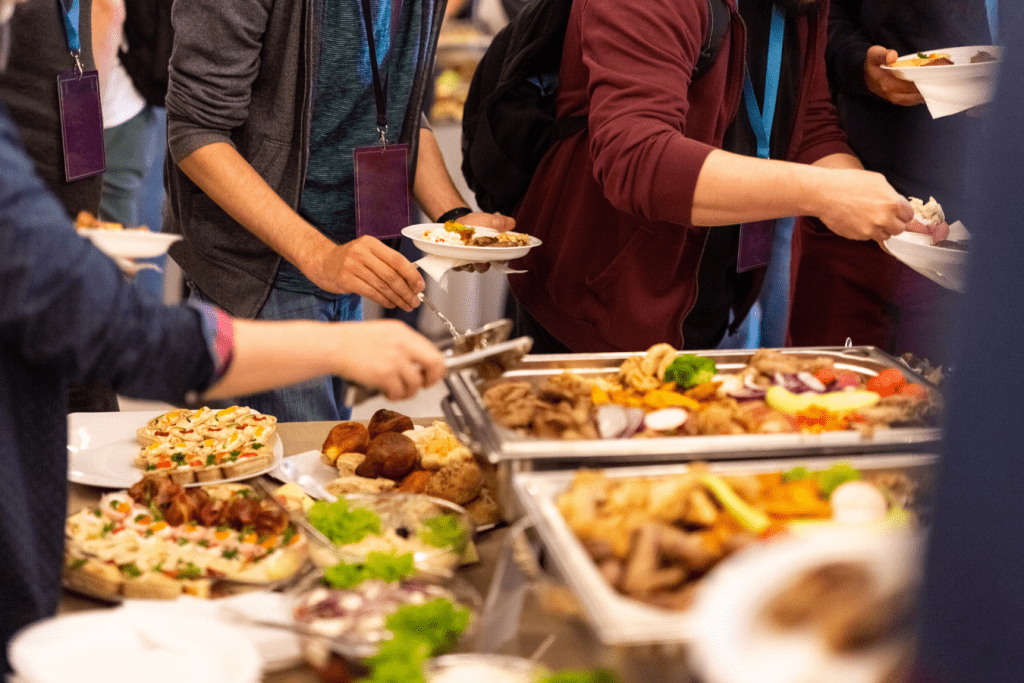
How they cook things differently?
By using their fresh local ingredients, some of which only found in this region, which mainly involves,
- Bamboo shoot, a soft, young part of a bamboo plant that looks like a little cone and can be cooked and eaten like a vegetable.
- Black sesame, a tiny, flat black seed that comes from the sesame plant and is used in food to add a nutty flavor and crunch—it’s also very healthy!
- Wild herbs like fermented soyabean
Many dishes are cooked slowly, using simple techniques passed down through generations.
What makes Shillong food special is how natural and comforting it feels. You’ll find smoked meats, soft rice dishes, light curries, and even steamed cakes.
Both vegetarians and non-vegetarians can enjoy the variety — from boiled vegetables and dal to pork, chicken, and fish prepared in traditional ways.
Whether you’re traveling with family, visiting for the first time, or a curious food blogger, Shillong has something to offer everyone. The food is gentle, warm, and perfect for the cool hill weather.
Now, let’s look at 10 local food in shillong you should try — each with its own story and taste that’s special to Shillong.
1. Jadoh
(Non-veg: Pork or chicken | Veg: Mushrooms or soy nuggets)
Jadoh is one of the most beloved and traditional food in Shillong — a true taste of Khasi culture. The name itself comes from the Khasi words “ja” (rice) and “doh” (meat), and it’s exactly that: rice cooked gently with meat and spices until the flavors blend beautifully.
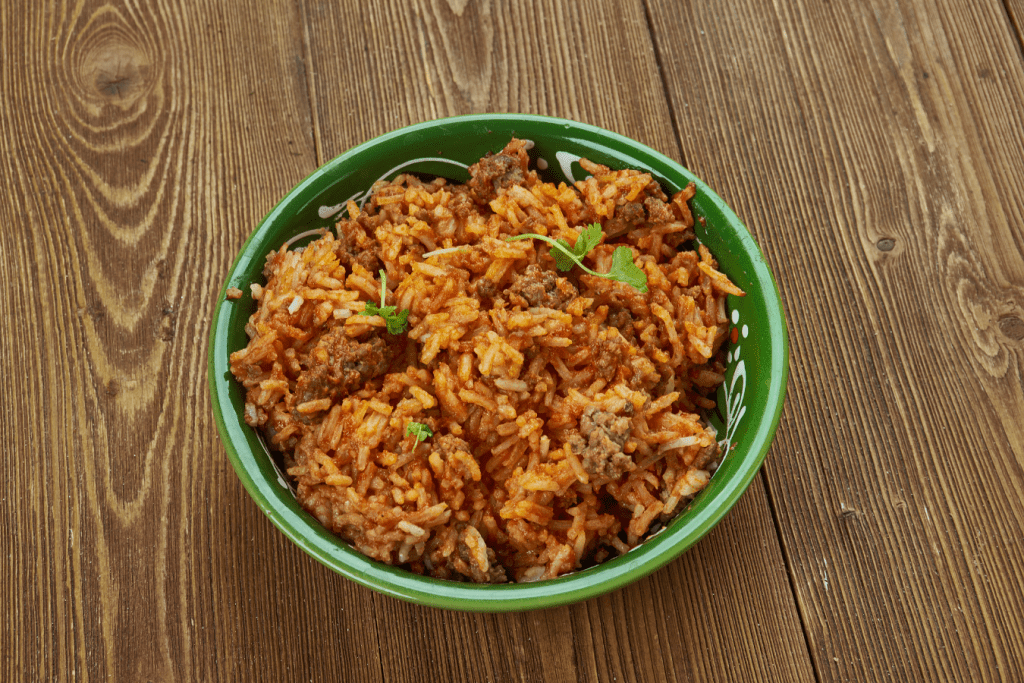
The most authentic version uses pork, often cooked with local herbs and sometimes a hint of black sesame or turmeric. Chicken is also used as a lighter alternative, while vegetarian versions made with mushrooms or soy chunks offer the same hearty feel.
The rice, usually a special red or local variety, absorbs the savory meat broth, turning soft, fragrant, and full of flavor. It’s not spicy, so it’s perfect for children, elders, or anyone new to Khasi shillong food. Jadoh is often enjoyed with a boiled egg, local pickles, or a light chutney on the side.
Next involves something smokey in look and taste.
2. Smoked Pork with Bamboo Shoot
(Non-veg only)
This is one of the most traditional and flavorful dishes you’ll find in the Khasi kitchen. The pork is first smoked over firewood — a local method that not only preserves the meat but gives it a rich, deep, smoky aroma.
After smoking, the pork is slowly cooked with thin slices of fermented bamboo shoot.
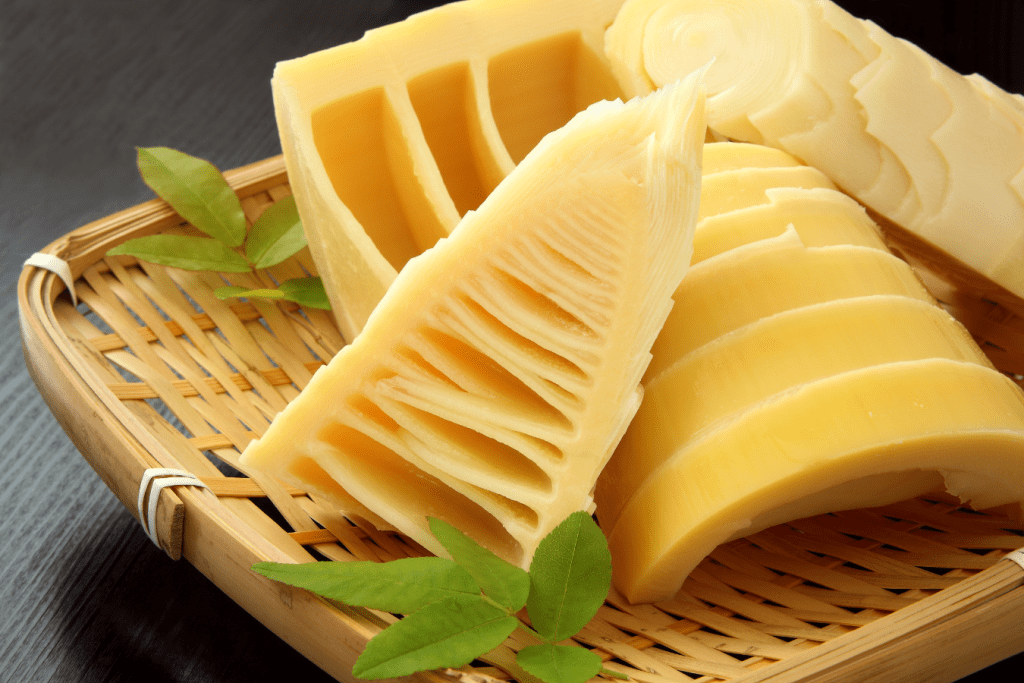
The bamboo shoot adds a tangy, slightly sharp flavor that perfectly balances the heaviness of the meat. Together, the smoky pork and sour bamboo create a bold, earthy taste that’s unlike anything found in other parts of India.
Served hot with plain rice or jadoh, this dish is especially loved during cooler months. It’s a dish that speaks of Khasi tradition, hillside cooking, and warmth — something best shared with family or savored slowly on a chilly Shillong evening.
3. Pumaloi (Steamed Rice Cake)
(Vegetarian)
Pumaloi is a gentle, comforting dish made from finely ground or broken rice, steamed in traditional Khasi bamboo containers. Its name comes from the Khasi words for “rice” (puma) and “powder” (loi), and true to its name, it’s soft, fluffy, and cloud-like in texture.
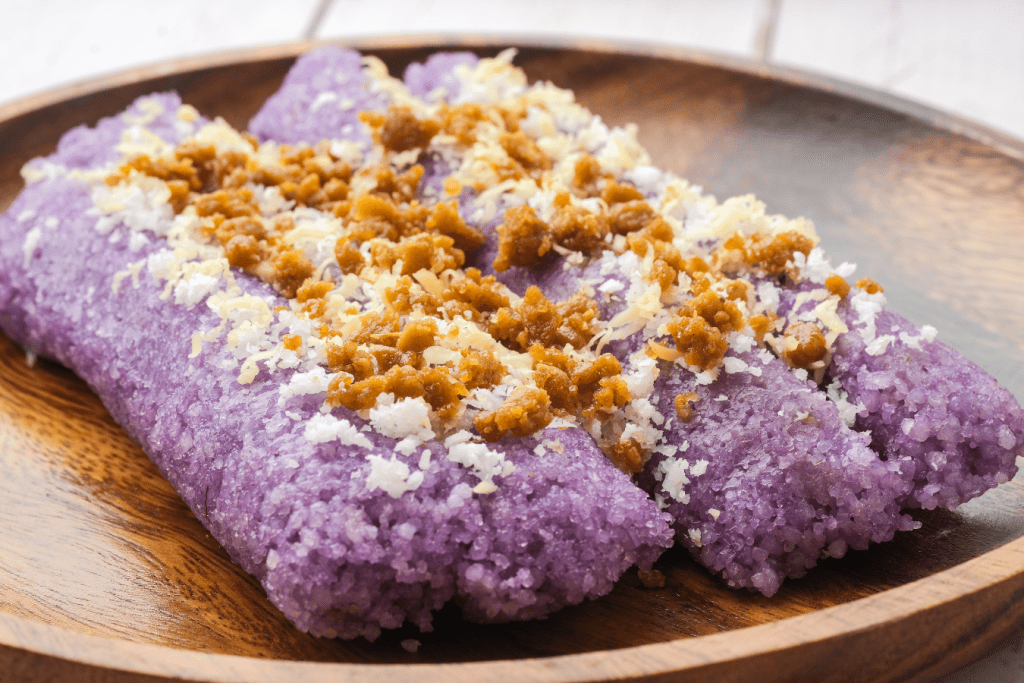
There are no strong spices or rich oils here — just the clean, natural flavor of rice. It’s often prepared for family gatherings, rituals, and festivals, making it not just a dish, but part of the region’s cultural heart.
What makes pumaloi special is its simplicity and versatility. It’s gluten-free, light on the stomach, and pairs beautifully with both sweet and savory sides. Locals enjoy it with tea in the morning, with mild curries for lunch, or with just a bit of salt and sesame oil for a snack.
Loved by kids and adults alike, pumaloi is one of those rare dishes that feels like home from the very first bite — especially on a quiet, misty Shillong afternoon.
4. Tungrymbai
(Non-veg: cooked with pork · Veg version: without meat)
Tungrymbai is one of the most traditional and distinctive dishes in Khasi cuisine. Made from fermented soybeans, it’s slowly cooked with onion, garlic, ginger, and sometimes pork for added richness. The result is a thick, savory paste with a deep, earthy flavor — often compared to a local version of miso, but with more texture and warmth.

What makes tungrymbai truly special is the way it’s prepared. In many Khasi homes, the soybeans are still fermented naturally — packed in bamboo baskets, wrapped in leaves, and left near the fire for days. This age-old method gives the dish its signature strong aroma and taste, which may seem unusual at first, but grows on you quickly.
The non-veg version has a smoky depth from the pork, while the vegetarian version is milder and commonly eaten with boiled vegetables, rice, or mashed potatoes. It’s high in protein, filling, and perfect for cool hill weather.
For those who want to taste the soul of Shillong food this is it. It may be simple in ingredients, but tungrymbai is rich in tradition, nutrition, and heart.
5. Chicken Stew with Local Herbs
(Non-veg)
This soothing dish is a staple in Khasi homes especially during cold evenings or when someone needs a gentle, nourishing meal. Unlike spicy Indian curries, this stew is light and clear, almost like a broth, made with tender chicken, fresh ginger, garlic, onions, and hill herbs such as bay leaves, mint, and black pepper.

What makes it special is its simplicity. The flavors aren’t heavy; instead, the stew is designed to warm the body and comfort the stomach. It’s often served with plain rice or pumaloi (steamed rice cake), making it a complete, balanced meal.
In Shillong, this stew is a go-to for families with kids or elders. It’s easy to digest, not spicy, and deeply comforting — much like a bowl of soup at home on a rainy day. For visitors, it’s a lovely introduction to Khasi-style cooking: gentle, natural, and full of warmth.
6. Boiled Rice and Khasi Dal
(Vegetarian)
This is one of the most humble yet beloved meals in Khasi households. It may sound simple just rice and lentils but the comfort it brings makes it special. The dal is usually made from yellow moong or masoor lentils, gently boiled with turmeric, a bit of ginger, and salt. Some families add onions or garlic, but it’s never oily or heavy.
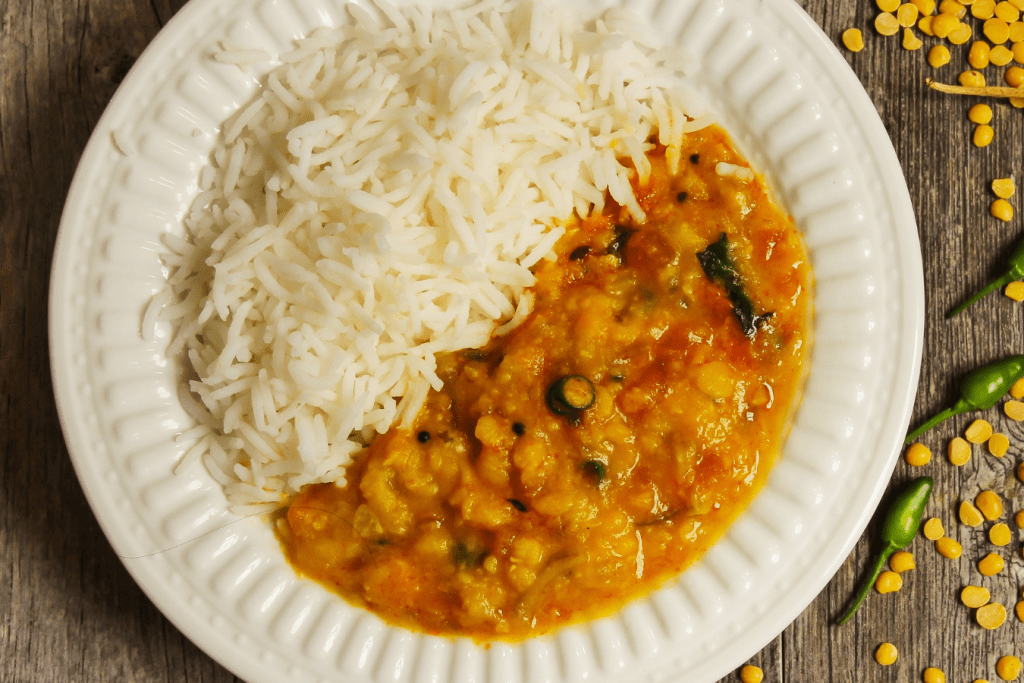
What makes Khasi dal different is its purity. There’s no overuse of spices or masalas — just clean, warm flavors that feel like home. Served with hot boiled rice and maybe a spoonful of local chutney or a piece of steamed pumpkin, it becomes a wholesome, satisfying meal.
In Shillong food, this dish is loved by everyone, kids, elders, vegetarians, and anyone looking for something light and nourishing. It’s also perfect if you’re not feeling too adventurous but still want a taste of local food. On a cool hill evening, this meal offers calmness in every bite, simple, soul-soothing, and deeply local.
7. Dry Fish with Mustard Greens
(Non-Veg)
This dish is one of the most traditional and beloved meals found in Khasi homes. It’s made by soaking dried river fish usually preserved through sun-drying or smoking and cooking it with mustard greens known locally as lai sa. The flavors are bold: the fish brings a deep, salty richness while the greens add a slightly bitter freshness. It’s a dish with strong taste and character, often served with plain rice and sometimes a fiery chili chutney.
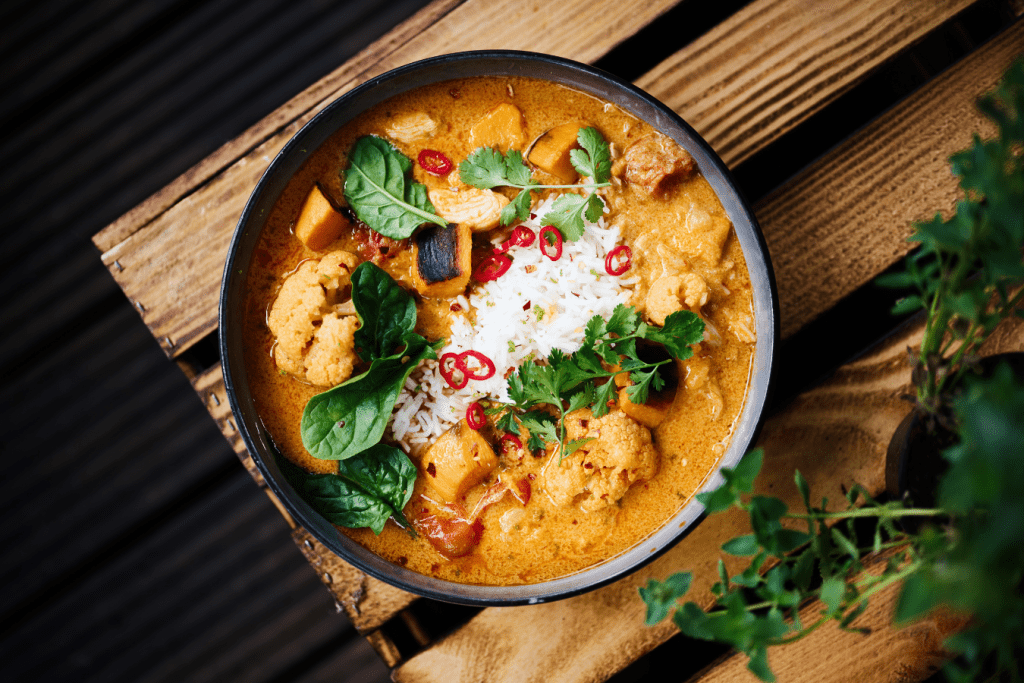
What makes this dish so special food in Shillong is its connection to everyday life in the hills. Drying fish has been a way for families to preserve food during cooler months or rainy seasons when fresh fish isn’t always available. The result is a unique flavor that can’t be found in fresh fish alone, smoky, earthy, and packed with local identity. While it may seem strong at first for those not used to it, for locals, it’s a taste of home, honest, humble, and deeply satisfying.
8. Local Vegetable Fry
(Vegetarian)
This simple yet flavorful dish is a staple on Khasi dining tables. It features seasonal vegetables like pumpkin leaves, wild fiddlehead ferns (daiñgai), mustard greens, squash, or jatropha leaves stir-fried lightly with just a touch of oil, garlic, or mustard seeds. Sometimes, ginger or green chilies are added for a bit of heat, but the seasoning remains minimal so the natural flavors shine through.
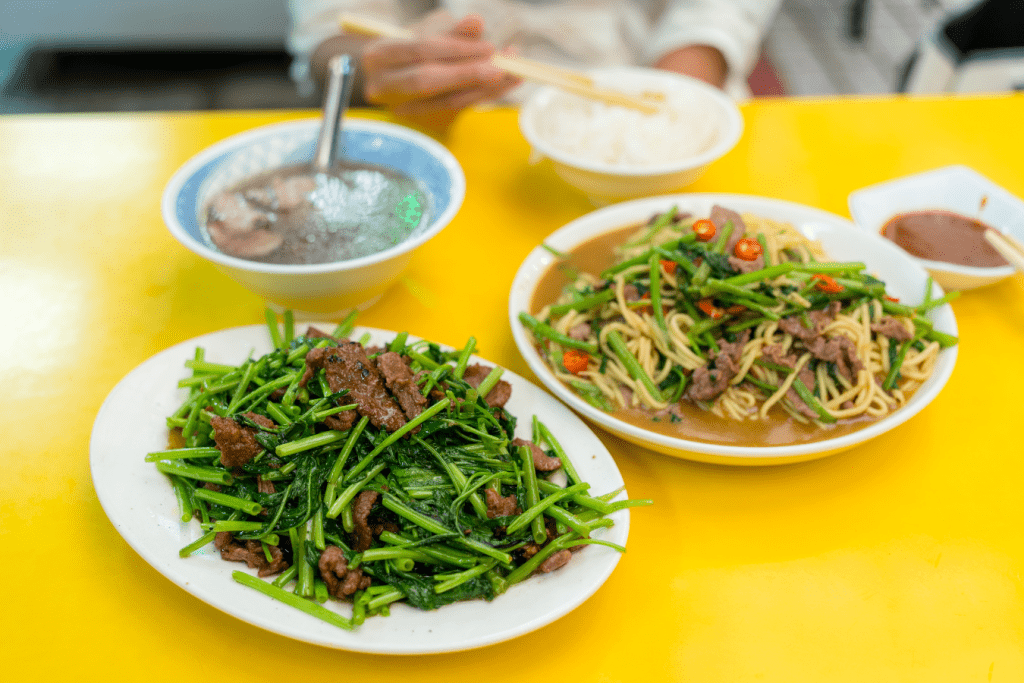
What makes this dish truly special is the vegetables themselves. Most of them grow only in the cool, hilly regions of Meghalaya and aren’t found in regular Indian markets. These greens are often foraged from the forest or grown in small kitchen gardens. They’re packed with nutrients, especially iron and fiber, and are valued not just for their health benefits but for the sense of place they bring to a meal. Eating this dish in Shillong food isn’t just about taste it’s about enjoying the freshness of the hills, one humble bite at a time.
9. Black Sesame Pork Curry
(Non-vegetarian)
One of the boldest and most flavorful dishes in Khasi cuisine, Black Sesame Pork Curry is a true delicacy from the hills of Shillong. It’s made by slow-cooking tender pieces of pork with a paste of roasted black sesame seeds, garlic, ginger, and sometimes a touch of local chili. The result is a thick, dark curry with a deep, nutty flavor that’s unlike anything found elsewhere in India.
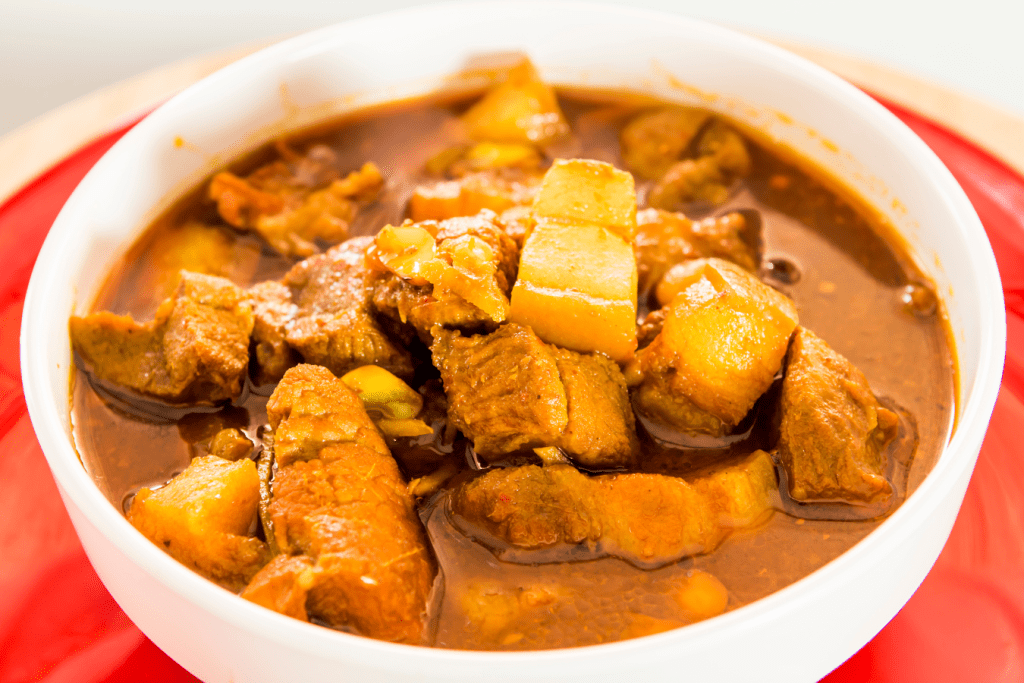
What makes this dish special is the use of black sesame, an ingredient deeply rooted in Khasi cooking. While sesame is used across Asia, the way it’s blended with pork in this region creates a rich, earthy taste that feels both festive and comforting. It’s often served during celebrations, family gatherings, or special occasions. Eaten with plain rice, the curry is warming, satisfying, and full of rustic charm that reflects the culinary heritage of Meghalaya.
10. Sohiong Chutney (Blackberry Chutney)
(Vegetarian)
A delightful way to end or accompany a Khasi meal, Sohiong Chutney is made from a native wild blackberry that grows only in the hills of Meghalaya. This deep purple chutney blends sweet and tangy flavors, often cooked down with just a bit of sugar and salt to highlight the fruit’s natural sharpness. It’s usually served during festive meals or alongside everyday dishes to balance savory flavors.
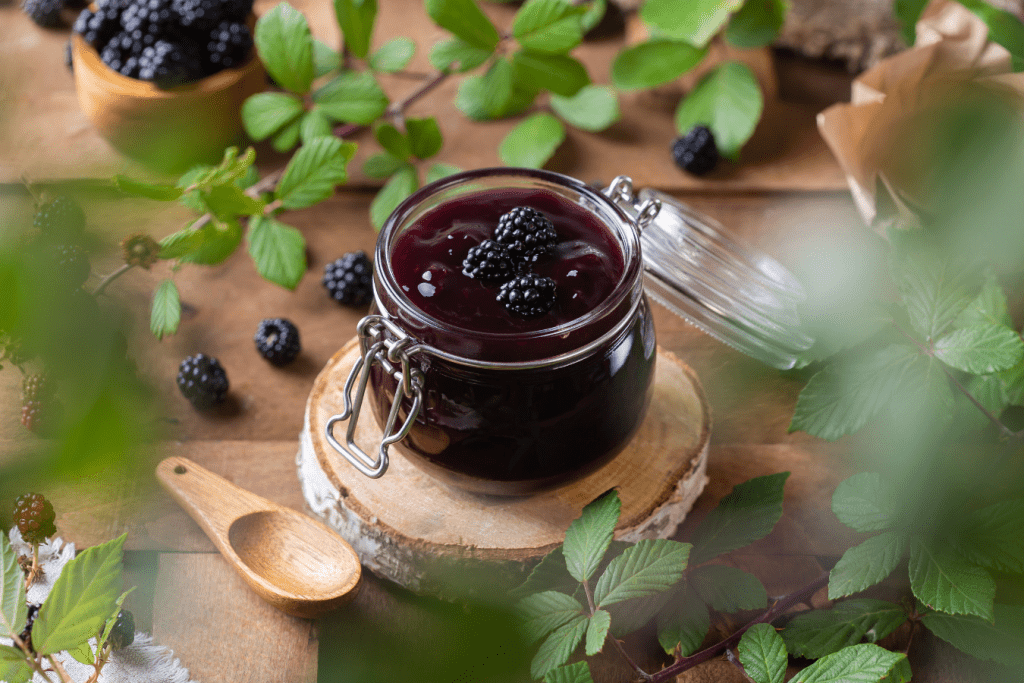
What makes Sohiong Chutney truly special is its origin — the sohiong fruit is found only in this part of the country, harvested seasonally and used fresh. The chutney not only brings a splash of color to the plate but also adds antioxidants and a unique mountain-fruit taste that kids and adults alike enjoy. Whether spread on flatbread, eaten with rice, or simply tasted by the spoon, it offers a sweet memory of food in Shillong wild and generous landscape.
Final Takeaway: A Plate Full of Shillong’s Heart
Food in Shillong is more than just a meal — it’s an experience you won’t find anywhere else. Each dish, whether it’s smoky pork, soft steamed rice cake, or a light lentil stew, brings you closer to the calm, caring, and nature-rich life of the Khasi hills.
For families, Shillong’s cuisine is gentle, clean, and nourishing — ideal for children and elders alike. Dishes like jadoh (a mild rice and meat preparation), pumaloi (steamed rice cake), and light lentil stew are wholesome choices that are easy to enjoy, even for sensitive palates.
For first-time visitors, the food offers a beautiful balance — rich in flavor but not overwhelmingly spicy. It’s the perfect introduction to Northeast Indian cuisine, with ingredients that feel familiar yet intriguing.
And for true food lovers, Shillong delivers bold, unforgettable tastes found only in this corner of India. Don’t miss local treasures like tungrymbai (fermented soybean delicacy), pork with bamboo shoot, or the tangy, wild sohiong chutney — each one a celebration of local ingredients and age-old cooking methods.
So take your time. Share these dishes with loved ones. Try both vegetarian and non-vegetarian food in Shillong. Let the meals be more than just food — let them be memories made at the table.
Food in Shillong – Frequently Asked Questions (FAQ)
1. What are some must-try traditional dishes in Shillong?
Some signature dishes include Jadoh (rice with meat), Tungrymbai (fermented soybean), Dohneiiong (pork with sesame), Pumaloi (steamed rice cake), and Sohiong chutney (a tangy wild berry relish).
2. Is the food in Shillong very spicy?
No, Khasi cuisine is known for its mild, earthy flavors. The spice level is generally low, making it suitable for children, elders, and those sensitive to strong spices.
3. What dishes are suitable for children or elders?
Gentle and nourishing dishes like Pumaloi, light lentil stew, boiled vegetables, and mildly seasoned Jadoh are perfect for both kids and elderly family members.
4. Are there vegetarian options available in Shillong?
Yes, vegetarians will find a good variety of dishes such as vegetable Jadoh, dal, stir-fried local greens, and seasonal vegetables cooked with minimal spices.
5. Where can I try authentic Khasi food in Shillong?
For traditional flavors, visit local spots like Trattoria, Cafe Shillong Heritage, or family-run homestays where meals are often prepared in the traditional Khasi style.
6. Can I enjoy local food while visiting waterfalls in Shillong?
Yes! Many waterfalls like Elephant Falls and Sweet Falls have small food stalls or nearby eateries where you can enjoy tasty local dishes like momos and Jadoh. You can also pack some local food and have a picnic while enjoying the beautiful views.
7. What should a food lover not miss in Shillong?
Food lovers should try bold local favorites like Tungrymbai, pork with bamboo shoot, Dohkhlieh (pork salad), Dohneiiong, and dishes featuring wild berries like Sohiong.
8. Is street food safe to eat in Shillong?
Yes, street food is generally safe and tasty. Choose vendors that are busy and maintain cleanliness. Popular items include momos, pakoras, and local snacks.
9. Are there options for people with dietary restrictions (gluten-free, lactose-free, etc.)?
Many dishes are naturally gluten-free and dairy-free, such as rice-based meals, vegetable preparations, and grilled meats in Shillong food. It’s best to confirm ingredients with the cook or server.
10. What are some local desserts to try?
Don’t miss Sakin Gata (sticky rice with sesame and coconut), sweet versions of Pumaloi, and seasonal delights like sohiong jelly.
11. Can I take any local food products home?
Yes! You can buy sohiong jam, dried bamboo shoots, local pickles, and spices from Shillong markets — great for souvenirs or enjoying a taste of Meghalaya at home.